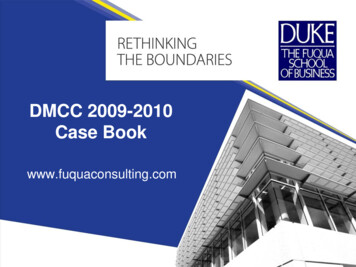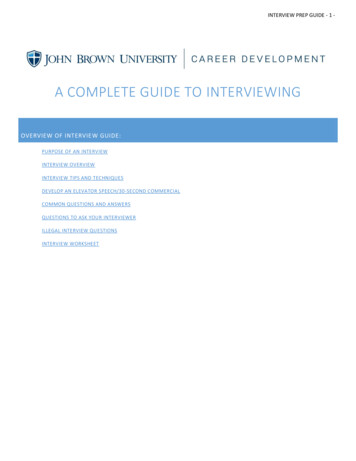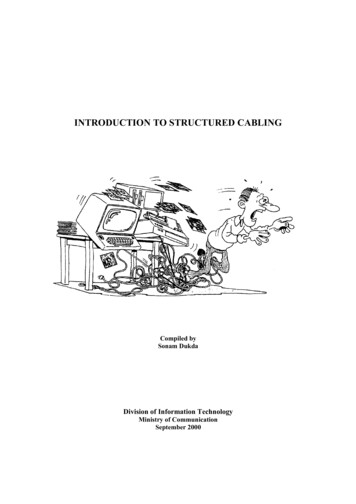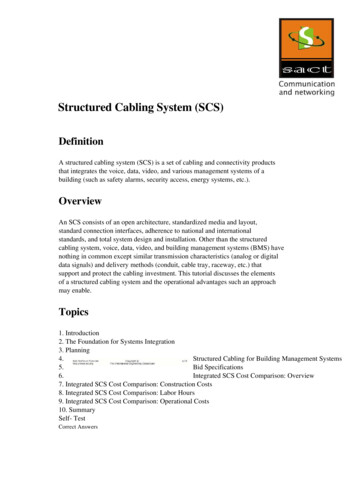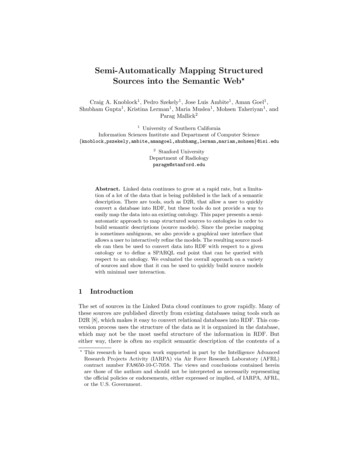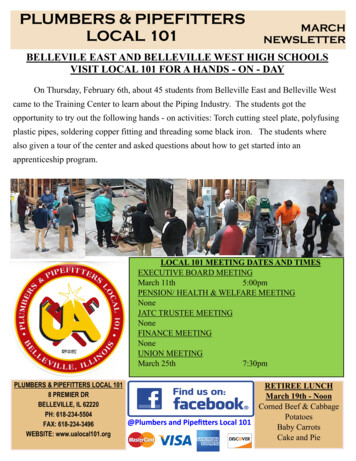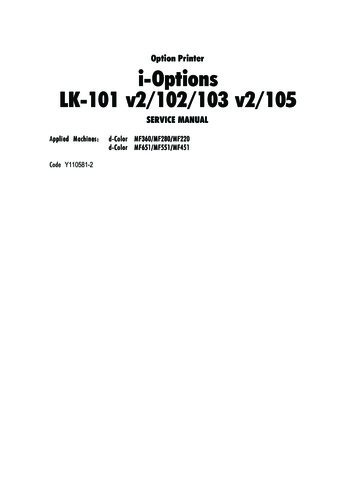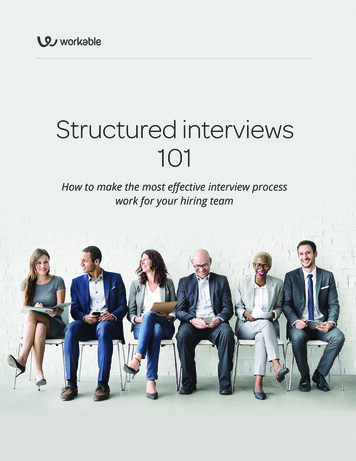
Transcription
Structured interviews101How to make the most effective interview processwork for your hiring teamStructured interviews 1011
ContentsIntroduction3What is structure?4Why does structure make interviews more effective?How to develop a structured interview process7Select the right requirements10Develop interview questions15Craft useful rating scalesHow to prepare interviewers19Assemble a hiring team21Prepare the hiring teamHow to conduct and evaluate interviews25Last minute interview tips26Evaluate candidates27Measure resultsStructured interviews 1012
IntroductionResearch has consistently found that structured interviews are much more reliableand valid than traditional, unstructured interviews. In fact, some research has shownthey’re almost twice as effective in predicting job performance.What is structure?Structure has been shown to influence interview validity more than anything else.But what makes an interview ‘structured’?Huffcutt & Arthur (1994) propose a “sophisticated framework for classifyinginterview structure.” This framework has two dimensions:Standardizing interview questionsStandardizing response scoringThese dimensions form a continuum. On one side, there are structuredinterviews where both dimensions are highly standardized. On the otherend, there are unstructured interviews, which have no standardization at all.Interviewers askrandom questionsInterviewers aregiven topicsto exploreStructured interviews 101Interviewers havelists of questionsto choose fromInterviewers ask thesame predeterminedquestions in aparticular orderto all candidates3
So, in structured interviews, hiring managers ask a set of predetermined questionsin a specific order. These questions are carefully created and linked to job-relevantcriteria based on job analysis. All responses are scored with the same rating systemusing scorecards.Unstructured interviews, on the other hand, flow like a friendly and spontaneousconversation. Their difficulty level follows interviewers’ moods. External factors andnew information could derail the process. Rating systems are implicit.Why does structure make interviews more effective?The more unstructured, the less job-related. Random and spontaneous questionsdon’t necessarily predict job performance. And, without a pre-determined scoringsystem, biases could run loose; interviewers could end up evaluating based ongender, race, physical attractiveness or, most commonly, how similar a candidateis to them.Structured interviews are job-related and allow for greater objectivity. They workwell in team hiring environments where individual biases are less likely to interfere.Companies that use structured interviews can also defend themselves better incourt. Research has shown that the amount of interview structure is strongly linkedto litigation outcomes. Unstructured interviews are challenged more often in courts.They’re also more likely to be found discriminatory since employers can’t prove theygive everyone the same opportunity to succeed.Structured interviews 1014
Structured interviews combat the problems that unstructured interviews pose.Granted, they might appear strict and impersonal for not allowing participants todigress from established processes. They also take time to prepare sinceinterviewers need to develop interview questions and rating scales with care.Despite some drawbacks, structured interviews can systematically predict jobperformance, especially when used alongside tests and work samples. Onceinterviewers have prepared their questions, defined their rating scales andestablished their processes, hiring can become easier and more effective for everyfuture position.Structured interviews 1015
How to develop astructured interviewprocessStructured interviews 1016
Select the right requirementsInterviewers often have a vague picture of their ideal candidate in mind. But, theycan’t consciously ask the right questions, unless they make a concise list of all theimportant traits they’re looking for.The first step is job analysis. It’s useful because it has been found to increase thevalidity of interviews. It identifies the qualifications a person needs to besuccessful in the job. This information may already be available, if the position isn’tnew. Template job descriptions can also help identify common qualifications foreach job. Results from a thorough job analysis will later help interviewers developinterview questions and rating scales.Then, interviewers identify general qualities that all employees should share.What will help a new hire fit in? Intelligence is a given in most cases, while integrityand dependability are common requirements. Employee and senior managementsurveys can help identify shared values. The human resources (HR) department ismore likely to take responsibility for defining these qualities to ensure consistencyacross teams.Although companies vary, here are some common requirements:Communication skillsEthical maturityDependabilityInitiativeWillingness to learnStructured interviews 1017
Once interviewers have the complete list, it’s time for them to trim it. Interviewsshouldn’t assess too many qualifications, or they risk exhausting candidates anddedicating too much time to collect adequate information.Decide which requirements to keep by answering three questions:Could this requirement be reliably assessed through another method?Interviews needn’t stand alone in the hiring process. Use tests, work samplesor background checks when possible.Is this requirement a must-have?It’s unlikely interviewers will hire a candidate who lacks leadership skills tomanage a large team. But, their decision might be different if they foundthat a candidate in an accounting position lacked social skills. Focus on the‘must-haves.’ Assess secondary qualifications in an additional round ofinterviews with comparable candidates.Could the candidate acquire this requirement on the job?This usually refers to specific knowledge rather than personality factors.Avoid rejecting candidates for not having easily taught skills or knowledge.Look for potential instead.Structured interviews 1018
It’s useful to provide a definition for each important requirement.For example, what does “excellent coding skills” mean? Which coding languagesdoes it refer to and what does it entail?Abstract soft skills might need a definition too. For example, what are interpersonalskills? An example of the US. Department of Personnel Management (OPM) definesthem as:“Shows understanding, friendliness, courtesy, tact, empathy,concern and politeness to others; develops and maintainseffective relationships with others; may include effectivelydealing with individuals who are difficult, hostile or distressed;relates well to people from varied backgrounds and differentsituations; is sensitive to cultural diversity, race, gender,disabilities and other individual differences.”Interviewers needn’t go into so much detail or invent new definitions.But, it’s important for hiring teams to agree on what each requirement stands for.Structured interviews 1019
Develop interview questionsConstruct the main interview questionsInterview questions should be job-related. Interviewers can choose interviewquestions from online libraries or they can develop their own with the help of HRprofessionals. Each question should link to a specific job requirement.There are many different interview question types and categories. This tablerepresents one way to think about them with examples:QUESTION TYPERole specificJob knowledgeSoft skillsGeneralCompanyknowledgeSoft skills/Culture fitWhat’s yourleadershipstyle?Who are ourcompetitors?GenericHow yould yourate yourknowledge ofExcel?Do you preferworkingas a team orautonomously?Tell me about atime you had todeal with adifficultcustomer.N/ABehavioralTell me about atime you usedSix Sigma for aproject.Tell me about atime someonecriticized yourwork and howyou responded.If I told you tomake some predictions based onthis case study,which metricswould you use?If you had twoimportantdeadlines comingup, how wouldyou prioritizeyour tasks?If ourcompetitor, X,released a newproduct, Y, howwould you advise our team torespond?If you discoveredyour supervisorwas breaking thecompany’s codeof conduct, whatwould you do?SituationalStructured interviews 10110
Role-specific interview questions depend on the position. Developing role-specificquestions is usually each hiring manager’s responsibility.General questions assess general requirements that all company employeesshould have. It’d be best if HR developed general questions, for consistency.Job knowledge questions usually evaluate hard skills like knowledge of relevantconcepts, legislation or tools. Interviewers can also ask candidates to completemini-assignments on a whiteboard or piece of paper. It’s best to avoid stuffing toomany of these questions into an interview. Job knowledge can be assessed throughtests and work samples. Tests are a better way to see if a candidate has enoughtheoretical knowledge to do the job.Company/Industry knowledge questions refer to how well candidates know thecompany.Soft skills interview questions measure personality traits or abstract skills.They could be framed in an abstract way, e.g. “Tell me about a time you had toexplain a difficult concept to a team member” or in a specific way, e.g. “How wouldyou explain the term ‘capital structure’ to a non-finance manager?”Behavioral and situational interview questions have been found to be generallyvalid in predicting job performance, with behavioral questions being slightly better.Behavioral interview questions explore candidates’ past experiences related tospecific requirements. Situational questions are hypothetical but always job related.Both are good options when you want to hear longer answers and get moreinformation about candidates. They should be based on real situations that crop upoften in candidates’ professions.Situational questions make candidates’ answers easier to compare and don’tusually need follow up questions. To reduce the possibility of faking the rightanswer, situational questions should pose a dilemma, when possible.Behavioral questions are better when candidates have comparable experience.Structured interviews 10111
You can use the STAR approach (Situation-Task-Action-Result) to frame yourbehavioral interview questions, along with any follow up questions. For example:“Tell me about a time you failed at a project (Situation/Task). How did you try toavoid failure? (Action). What did that experience teach you? (Result).”General guidelines for writing interview questions:Develop a set of questions for each requirementUse real-life situationsBe clear and conciseAvoid jargonEnsure questions can’t be answered with a simple ‘yes’ or ‘no’Avoid questions that point to a right answerAvoid adding excessive detailDon’t try to assess anything non-job related(especially protected characteristics)Ask someone who wasn’t involved in writingquestions to review themStructured interviews 10112
Learn to use follow up questionsStructured interviews don’t leave much room for improvising questions. But followup (or probing) questions can help interviewers if candidates give unclear answers.The way interviewers frame these questions matters. If they’re framed in a way thatreveals what interviewers expect, they can increase the probability of a candidatefaking the right answer. For example, imagine interviewers asking candidates howthey would handle a difficult colleague. Follow up questions like “would you getangry after a confrontation and tell your boss” give candidates pointers as to whatthey should say.But, probing questions could have the opposite effect, if they merely encouragecandidates to share more details without pointing to a right answer. For this reason,probing questions should be asked with caution.Here’s an example of an exchange between a candidate and an interviewer:Tell me about a time you successfully managed a team for a project.I was working on a software development project and I was put in charge ofan engineering team. We managed to finish on time and with great success.How many members were on your team and what were theirresponsibilities? What were your team’s deliverables?Structured interviews 10113
The first follow up question is meant to verify the candidate’s claims by askingfor more detail. The second question is a tweaked version of a general STARquestion, “What was the result?” Interviewers often need to paraphrase thequestion to clarify a point.Interviewers could also create a list of probing questions that fit every situation like:Who was involved?Where did that happen?What was your specific role?What would you do if that action didn’t work?Ask an appropriate number of questionsIt’d be a good idea to ask more than one interview question for each requirement.Some researchers advise to use more than three. It all depends on time constraints.Some requirements are more important than others so interviewers might use morequestions for them. Probing questions should be limited. Ask only a couple whenneeded.Order questionsThe questions’ order depends on which skills should be assessed first.Hard skills are usually assessed through other reliable means like tests, worksamples or assignments. If not, start with hard skills interview questions to makesure candidates can do the job - cultural fit would be irrelevant if they couldn’t.Then, ask soft skills questions. One way would be to begin with role-specificquestions and then general ones. It’d be a good idea to start positive: ask first aboutcandidates’ successes and interests, instead of mistakes and failures.Structured interviews 10114
Craft useful rating scalesDevelop a scoring systemA scoring system is very important to ensure objective decisions. Most interviewerschoose the common scale of five or seven points. The key here is to accuratelydefine the scoring levels. Research shows that defining all levels makes scoring moreresilient against disability bias because interviewers have clear job-relevant criteriain front of them when assigning any score. It’s possible that defining all scores willhave the same effect on other types of biases too.Definitions can vary from unsatisfactory to satisfactory or low to high. It depends onhow interviewers would like to evaluate candidates’ answers. They could alsodevelop general definitions of each level. For example, ‘unsatisfactory’ could mean:Never or rarely demonstrates the skillDemands very close supervision to meet minimum criteria of the skillIt’s often useful to develop more detailed scales for certain skills. According to theexample from Office for Personnel Management (OPM) for interpersonal skillsmentioned above, the grading scale can look like this:Level 1 - Low: Handles interpersonal situations involving little or no tension ordiscomfort and requires close guidanceLevel 3 - Average: Handles interpersonal situations involving a moderate degree oftension or discomfort and requires occasional guidanceLevel 5 - Outstanding: Handles interpersonal situations involving a high degree oftension or discomfort and advises othersStructured interviews 10115
This is an example of “behaviorally anchored rating scales (BARS).” All points areaccompanied by descriptions of behaviors. These descriptions are called “behavioralindicators.” They give interviewers an idea of how to score candidates. They couldeither be intuitively defined, or modeled after real employee behaviors using theCritical Incident Technique (CIT).Of course, it’s impossible to make an exhaustive list of behaviors for each point ofthe scale. For example, when evaluating teamwork, interviewers could useinformation from job analysis to develop many behavioral indicators for lowteamwork skills and high teamwork skills:Low teamwork skills:Talks about their previous teams in a hostileand aggressive wayOnly cares about completing their own tasks and fails toacknowledge the team’s effortHigh teamwork skills:Praises their team’s collective effort and success infront of othersTakes initiative to resolve team conflictsStructured interviews 10116
Interviewers could also define unacceptable answers. For example, if they want toask candidates about a time they made a mistake, they could define the followingunacceptable answers:What do you care?I don’t make mistakesIt’s top secretOr veiled variants:“I’m always very careful when doing things. I use my great intelligenceand attention to detail to avoid mistakes that could harm my performance.To this day, I’ve managed to do everything as it should be done.”Choose a rating scaleInterviewers could practically choose any rating system they want.Pass/fail or positive/negative systems make more sense for yes/no questions.Structured interviews 10117
How to prepareinterviewersStructured interviews 10118
Assemble a hiring teamIt’s best to use multiple interviewers to temper individual biases and cancel outrandom errors. And it’s better when all candidates meet the same interviewers.Hiring teams usually include two or more of the following:The position’s direct supervisorAn HR professionalA team memberThe previous incumbentThe department’s directorDirect supervisors and previous employees who did this job (if they’re still around)are good choices. Hiring teams should also be as diverse as possible to reducegender, race and similarity biases.Structured interviews 10119
How will interviews be held?There are two ways that multiple interviewers can interview candidates:1. An interview panelIn this format, all interviewers hear the same answers so they can more easilydiscuss their ratings afterwards. They’re also more likely to catch all relevantinformation.Interview panels make candidates more uncomfortable than usual so avoid turningthe panel into a firing squad. Try to help candidates relax and leave enough timebetween questions. It’s also best not to make candidates sit on a chair facing aninterview panel. Opt for a round table instead.2. A series of 1:1 interviewsIn this format, interviewers have access to more information since each one asksdifferent questions to evaluate predetermined traits. That way they can evaluatecandidates from a broader perspective. There’s indication that this format makesinterviewers’ ratings more independent and reliable.Structured interviews 10120
Prepare the hiring teamMost interviewers like relaxed conversations with candidates. It might be difficultto persuade them that this approach isn’t very effective. It could be even harder toensure they won’t stray from predetermined interview questions to explore otherinteresting topics.A good way to start is by helping interviewers:Understand the merits of structured interviewsBecome more aware of hiring objectivesUnderstand and use processes correctlyLearn how to minimize biasesTrain interviewersTraining should include many elements. First, interviewers should understand theprocess of structuring interviews. They’ll often have to craft their own interviewquestions for a position. Present the process of defining requirements and creatinginterview questions. Companies might use one universal rating scale or leave it toeach hiring manager to decide which one to use. In both cases, interviewers need tounderstand how to use/create a rating scale. These training sessions only need to bedone once, if planned correctly.Structured interviews 10121
Educating interviewers about how to make candidates feel comfortable is a goodidea. Needless to say, they should be trained in preserving legality during interviews(e.g. avoiding illegal interview questions).Interviewers should also be trained in note-taking, regardless of the interviewformat. Taking notes is important because interviewers can remember answers andjustify their ratings.Note-taking can take many different forms. Research shows that the moststructured form of note-taking results from:Extensive notes instead of brief notesMandatory note-taking instead of optional note-takingRecording answers or facts instead of evaluations or judgementsNote-taking during the interview instead of after the interviewWhatever the format, interviewers should take notes about:Important parts of answers that will help them remember whatcandidates saidConcerns about job-related criteriaExtreme behaviorsStructured interviews 10122
Interviewers shouldn’t take notes about:Protected characteristics, like race and genderSubjective criteria, like “we went to the same school”Traits that aren’t job related, like physical attractivenessExcusable behaviors, like nervousnessNote that video interviews with a recording function can eliminate the needfor note-taking.Combat biasesThis may be the most difficult part of interviewing. Combating biases meansinterviewers have to work against their inherent tendencies. It takes time andconscious effort. Training can certainly help, if only to make interviewers aware thatthese biases actually exist. For example, taking an Implicit Association Test (IAT) canhelp people identify any unconscious preferences for specific races, religions etc.Educate interviewers in equal opportunity practices. Give interviewers guidance onhow to minimize the effects of their biases. One way is to teach interviewers abouthow to spot their subtle expressions. Another way is to encourage interviewers topractice slowing down their judgement and decision making process.Structured interviews 10123
How to conduct& evaluate interviewsStructured interviews 10124
Last minute tipsRead candidates’ resumes. You can only fully understand their answersif you know their background. And, it can help you ask relevant probingquestions.Prepare to take your time. Don’t schedule meetings right after interviews.Sometimes you need more time and it’d be rude to rush candidates.Break the ice. Spend the first two minutes of interviews in pleasantunstructured talk with candidates. This can soften the impersonal sideof structured interviews. Don’t get carried away though, limiting extraneousinformation can increase interview validity, by keeping judgementsjob-related. Keep it brief and simple, and avoid evaluating candidatesduring this time.Show you care. Having predetermined questions doesn’t mean you haveto act like a machine. Show interest in the candidate and listen carefully.Make eye contact. Even if interviewers are taking extensive notes, theyshould minimize the time spent looking at their notebooks or laptop screens.Offer to answer questions. Candidates usually want additional informationduring their interview. When following a structured interview format, it’s bestto ask candidates to ask questions after the structured portion of theinterview ends. Candidate questions during the interview could lead thediscussion away from its structured path.Structured interviews 10125
Εvaluate candidatesAfter interviews, interviewers should evaluate each answer. It’s better forinterviewers to do this after they’ve seen all candidates, so they can rate all of themin one question first, before moving on to the next question.This is a way to lessen the ‘halo effect.’ When a candidate shows exceptional skills inone area, interviewers can be tempted to rate them favorably in other areas wherethey mightn’t be as strong. Interviewers can reduce the ‘halo effect’ by ratingcandidates horizontally, based on a single question.After interviewers have rated all questions, they could rate candidates accordingto predetermined traits. Interviewers will evaluate each trait by using the ratings ofquestions that measure that trait. For example, imagine that three questions weredesigned to measure one specific trait. A candidate’s overall score for that trait willbe the average of their score in each of these three questions. Panel interviewerscould do this together since they’ve all heard and scored the same responses.If interviewers used the interview series format, they’ll have probably asked differentquestions evaluating each trait. So, they could rate predetermined traitsindividually, based on how they rated candidates’ responses. Then, interviewers canpresent these scores to their team and compare them. A discussion where allinteviewers consult notes and explain their ratings is a good idea.After their discussion, interviewers can decide on their final ratings for each candidate (with or without input from other selection methods, e.g. test scores).Different interviewers’ scores can have different weights. For example, hiringmanagers’ scores could weigh more than team members’ scores.Structured interviews 10126
Measure resultsHow can you measure the success of your structured interview process?A good hire is a good indication. But, it’s best if you systematically track recruitmentdata to ensure you’re getting the most out of structured interviews. For example,structured interviews are meant to increase diversity. If your recruitment datasuggests that you hire homogeneously, then you might need to rethink interviewers’training or the hiring process.It’s a good idea to include recruiting metrics when evaluating interviews.They give quantitative data that will help you decide if your process works or if it’scost-effective. Examples of recruiting metrics include:Quality of hireTime-to-hireTime-to-fillInterviews per hireStructured interviews 10127
About WorkableWorkable is trusted by over 5000 companies globally, to streamline theirhiring. From posting a job to sourcing candidates, Workable providesthe tools you need to manage multiple hiring pipelines. Transparentcommunication, organized candidate profiles, structured interviews and afull reporting suite gives hiring teams the information they need to makethe right choice. Workable is available for desktop and mobile.OVER 5000 COMPANIES TRUST WORKABLE TOSTREAMLINE THEIR HIRING, INCLUDING:Structured interviews 10128
Structured interviews 101 4 So, in structured interviews, hiring managers ask a set of predetermined questions in a specific order. These questions are carefully created and linked to job-
